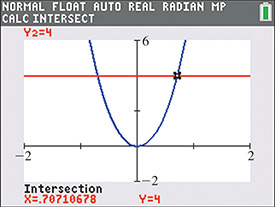14.3 Equations in Quadratic Form
Substituting to Fit Quadratic Form • Solving Equations in Quadratic Form • Extraneous Roots
Often, we encounter equations that can be solved by methods applicable to quadratic equations, even though these equations are not actually quadratic.
NOTE
[They do have the property, however, that with a proper substitution they may be written in the form of a quadratic equation.]
All that is necessary is that the equation have terms including some variable quantity, its square, and perhaps a constant term. The following example illustrates these types of equations.
EXAMPLE 1 Identifying quadratic form
The equation is an equation in quadratic form, because if we let we have and the resulting equation is




The following examples illustrate the method of solving equations in quadratic form.
EXAMPLE 2 Solving an equation in quadratic form
Solve the equation
We first let to write the equation in quadratic form. We will then solve the resulting quadratic equation for y. However, solutions for x are required, so we again let to solve for x.
We can let and to solve the system on a calculator. The display is shown in Fig. 14.15, and we see that there are two points of intersection, one for (shown on screen) and the other for (not shown). Because this verifies the real solutions. The imaginary solutions cannot be found graphically. Substitution of each value in the original equation shows each value to be a solution.

Fig. 14.15
Graphing calculator keystrokes: bit.ly/
Two of the solutions in Example 2 are complex numbers. We were able to find these solutions directly from the definition of the square root of a negative number. In some cases (see Exercise 22 of this section), it is necessary to use the method of Section 12.6 to find such complex-number solutions.
EXAMPLE 3 Solving an equation with a square root
Solve the equation
By letting we have
Since cannot be negative, the only solution is This solution checks when substituted in the original equation.
The graph of is shown in the calculator display in Fig. 14.16. Note that is the only solution shown.

Fig. 14.16
Graphing calculator keystrokes: bit.ly/
CAUTION
Example 3 illustrates a very important point. Whenever an operation involving the unknown is performed on an equation, this operation may introduce roots into a subsequent equation that are not roots of the original equation. Therefore, we must check all answers in the original equation.
Only operations involving constants—that is, adding, subtracting, multiplying by, or dividing by constants—are certain not to introduce the extraneous roots. We first encountered the concept of an extraneous root in Section 6.7, when we discussed equations involving fractions.
EXAMPLE 4 Solving an equation with negative exponents
Solve the equation
By substituting we have To solve this equation, we may use the quadratic formula:
Since we have
These answers in decimal form are
These results check when substituted in the original equation. In checking these decimal answers, it is more accurate to use the calculator values, before rounding them off. This can be done by storing the calculator values in memory.
EXAMPLE 5 Solving an equation with grouped terms
Solve the equation
By substituting we have
Solving each of these equations, we have
Each value checks when substituted in the original equation.
EXAMPLE 6 Quadratic form—cell phone screen
An advertisement for a cell phone states that it has a 106-mm screen (diagonal) with an area of Find the length l and width w of the screen. See Fig. 14.17.

Fig. 14.17
Because the required quantities are the length and width, let length of the screen and let width. Because the area is Also, using the Pythagorean theorem and the fact that the diagonal is 106 mm, we have the equation Therefore, we are to solve the system of equations
Solving the first equation for l, we have Substituting this into the second equation, we have
Let
Therefore, or
Solving for w, we get or Only positive values are meaningful in this problem, which means if then (or ). Checking with the statement of the problem, we see that these dimensions for the screen give an area of and a diagonal of 106 mm.
EXERCISES 14.3
In Exercises 1 and 2, make the given changes in the indicated examples of this section and then solve the resulting equations
In Example 2, change the before the to and then solve the equation.
In Example 3, change the 2 to 6 and then solve the equation.
In Exercises 3–28, solve the given equations algebraically. In Exercise 10, explain your method
In Exercises 29–34, solve the given equations algebraically and check the solutions with a calculator
In Exercises 35–42, solve the given problems algebraically.
Solve for
A paper drinking cup in the shape of a cone is constructed from of paper. If the height of the cone is 4 in., find the radius. (Hint: Lateral surface area )
The equivalent resistance of two resistors and in parallel is given by If and find and
An equation used in the study of the dispersion of light is Solve for (See the chapter introduction.)
In the theory dealing with optical interferometers, the equation is used. Solve for p if
A special washer is made from a circular disc 3.50 cm in radius by removing a rectangular area of from the center. If each corner of the rectangular area is 0.50 cm from the outer edge of the washer, what are the dimensions of the area that is removed?
A rectangular TV screen has an area of and a diagonal of 60.0 in. Find the dimensions of the screen.
A roof truss in the shape of a right triangle has a perimeter of 90 ft. If the hypotenuse is 1 ft longer than one of the other sides, what are the sides of the truss?
Answers to Practice Exercises
1
